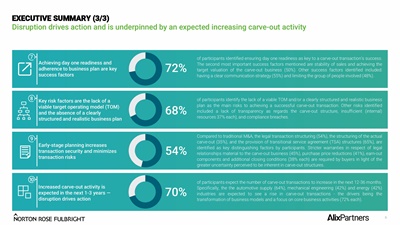
6
EXECUTIVE SUMMARY (3/3)
Disruption drives action and is underpinned by an expected increasing carve-out activity
Achieving day one readiness and
adherence to business plan are key
success factors
of participants identified ensuring day one readiness as key to a carve-out transaction's success.
The second most important success factors mentioned are stability of sales and achieving the
target valuation of the carve-out business (50%). Other success factors identified included:
having a clear communication strategy (55%) and limiting the group of people involved (48%).
72%
Key risk factors are the lack of a
viable target operating model (TOM)
and the absence of a clearly
structured and realistic business plan
Early-stage planning increases
transaction security and minimizes
transaction risks
of participants identify the lack of a viable TOM and/or a clearly structured and realistic business
plan as the main risks to achieving a successful carve-out transaction. Other risks identified
included a lack of transparency as regards the carve-out structure, insufficient (internal)
resources 37% each), and compliance breaches.
68% Compared to traditional M&A, the legal transaction structuring (54%), the structuring of the actual
carve-out (35%), and the provision of transitional service agreement (TSA) structures (65%), are
identified as key distinguishing factors by participants. Stricter warranties in respect of legal
relationships material to the carve-out business (45%), purchase price reductions (41%), earn-out
components and additional closing conditions (38% each) are required by buyers in light of the
greater uncertainty perceived to be inherent in carve-out structures.
54%
Increased carve-out activity is
expected in the next 1-3 years -
disruption drives action
of participants expect the number of carve-out transactions to increase in the next 12-36 months.
Specifically, the the automotive supply (64%), mechanical engineering (42%) and energy (42%)
industries are expected to see a rise in carve-out transactions - the drivers being the
transformation of business models and a focus on core business activities (72% each).
70%
7
8
9
10